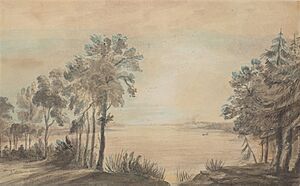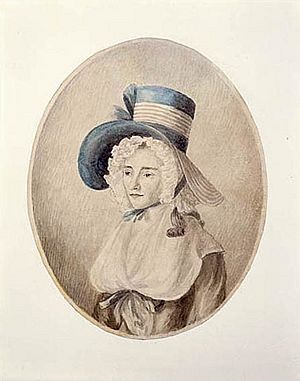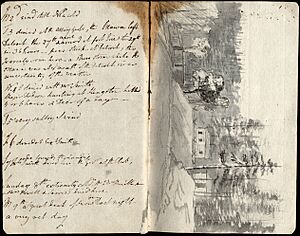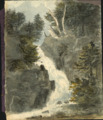Elizabeth Simcoe facts for kids
Dame Elizabeth Posthuma Simcoe (born September 22, 1762 – died January 17, 1850) was an English artist and diarist. She lived in colonial Canada, which means Canada when it was a British colony. Her husband, John Graves Simcoe, was the first leader (called the Lieutenant Governor) of Upper Canada. Her detailed diary gives us a great look into what life was like in Canada during that time.
About Elizabeth Simcoe
Elizabeth was born as Elizabeth Posthuma Gwillim in Aldwincle, Northamptonshire, England. Her father, Thomas Gwillim, passed away before she was born. Sadly, her mother also died shortly after Elizabeth's birth. Because she was born after her father's death, she was given the middle name "Posthuma."
After her baptism, Elizabeth was cared for by her mother's younger sister, Margaret. Margaret later married Admiral Samuel Graves in 1769. Elizabeth grew up at their home, Hembury Fort, near Honiton in Devon. She was friends with a group of people in Honiton, including Mary Anne Burges.

On December 30, 1782, Elizabeth married John Graves Simcoe, who was Admiral Graves's godson. Between 1784 and 1804, Elizabeth and John had eleven children. Nine of their children lived to be adults. Their daughter Katherine, who was their only child born in Upper Canada, and their son John Cornwall Simcoe, both died when they were babies. Katherine is buried at Fort York Garrison.
Elizabeth was a very wealthy heiress. She owned a large property of 5,000 acres (about 2,025 hectares) near Honiton, Devon. She built a house there called Wolford Lodge, which stayed in the Simcoe family until 1923. Elizabeth is buried at Wolford Chapel.
Elizabeth Simcoe's Important Legacy
Elizabeth Simcoe's diary is very important because it gives us a clear picture of what life was like in early Ontario when it was a British colony. Her diary was first published in 1911. Later, a new version was made in 1965, and a paperback book came out around the year 2000, more than 200 years after she wrote it!
Elizabeth also created 595 beautiful watercolour paintings. These paintings show scenes from the town of York, Upper Canada, which is now the city of Toronto. She even suggested naming Scarborough Township, an area in eastern Toronto, after Scarborough, North Yorkshire in England.
Several places in Ontario are named after her family. The townships of North Gwillimbury, East Gwillimbury, and West Gwillimbury, which are just south of Lake Simcoe, are named after her family name. The Township of Whitchurch, now known as Whitchurch–Stouffville, Ontario, honors her birthplace.
In December 2007, a statue of Elizabeth Gwillim Simcoe was put up in the town of Bradford West Gwillimbury. This happened when the town celebrated its 150th anniversary. The statue stands in a small park in front of the Bradford post office.
Images for kids





